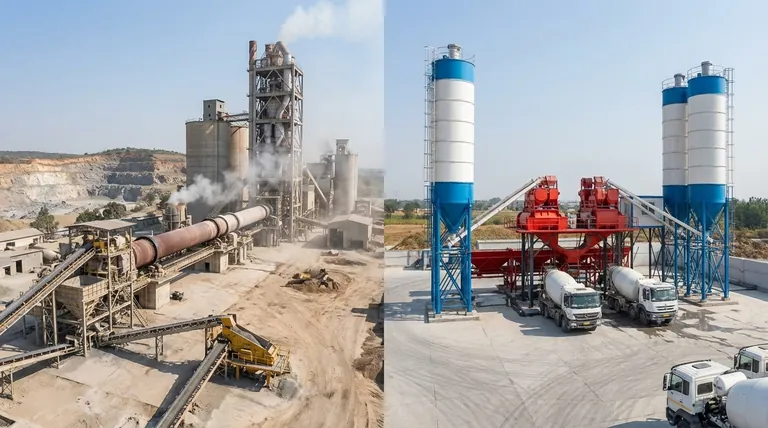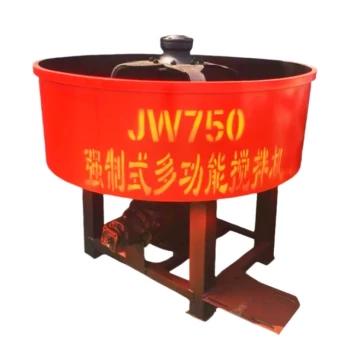In short, a cement plant creates a key ingredient, while a concrete plant mixes the final product. A cement plant is a heavy industrial facility that mines limestone, heats it in a massive kiln, and grinds it into the fine powder we know as cement. A concrete plant, often called a "batch plant," is a much simpler operation that combines this cement with water, sand, and rock to create ready-mix concrete for construction projects.
The core distinction is one of manufacturing versus mixing. A cement plant manufactures a binding agent from raw earth materials. A concrete plant is a distribution hub that mixes that manufactured agent with other ingredients to create a perishable final product.

The Role of the Cement Plant: Manufacturing the Binder
A cement plant is the origin point of the chemical process. It takes a raw natural resource and fundamentally transforms it into a new, manufactured product.
From Raw Material to Powder
The process begins at a quarry, where limestone and other minerals are mined from the earth. These raw materials are crushed into a manageable size.
The Kiln and Chemical Transformation
The crushed rock is fed into an enormous, rotating kiln and heated to extremely high temperatures (around 1450°C or 2640°F). This intense heat causes a chemical reaction that creates a new, marble-sized substance called clinker.
The Final Grind
This clinker is the intermediate product. It is cooled and then ground into an extremely fine powder. A small amount of gypsum is added during grinding to control setting time, and the result is the finished product: Portland cement.
The Role of the Concrete Plant: Mixing the Final Product
A concrete plant, or batch plant, does not manufacture any ingredients. Its sole function is to accurately combine the components to make ready-mix concrete.
Receiving the Ingredients
A concrete plant receives shipments of finished products from other facilities: cement from a cement plant, and sand and gravel (known as aggregates) from a quarry. Water is supplied locally.
The Batching Process
The plant's equipment precisely measures, or "batches," each ingredient according to a specific mix design. These components are then loaded into a concrete mixer truck, where they are blended together, usually during transit.
Delivery to the Job Site
Concrete is a time-sensitive product that begins to harden once mixed. The primary role of the concrete plant is to mix the product just in time for delivery and placement at a nearby construction site.
Common Pitfalls: Why the Confusion Exists
The widespread confusion between these terms is understandable, as they are often used interchangeably in everyday language, even though they are technically distinct.
The Sidewalk Misnomer
People often refer to a "cement sidewalk" or a "cement mixer." In reality, the sidewalk is made of concrete, and the truck is a concrete mixer. Cement is just the fine gray powder that acts as the glue within the concrete.
One is an Input, the Other an Output
The easiest way to remember the difference is to think in terms of process flow. Cement is an input for a concrete plant. Concrete is the output of a concrete plant. You cannot make one without the other.
Making the Right Choice for Your Understanding
Your mental model should be based on the role each facility plays in the supply chain.
- If your primary focus is on raw material transformation: A cement plant is a manufacturing facility that converts quarried rock into a chemically active binding powder.
- If your primary focus is on the final construction material: A concrete plant is a mixing and distribution facility that combines that powder with aggregates and water to create the material poured on a job site.
Understanding this distinction clarifies the entire journey of our most essential building material from the earth to our infrastructure.
Summary Table:
| Aspect | Cement Plant | Concrete Plant |
|---|---|---|
| Primary Function | Manufacturing | Mixing & Distribution |
| Core Process | Chemical transformation in a kiln | Batching & combining ingredients |
| Input Materials | Limestone, clay, minerals | Cement, water, sand, gravel (aggregates) |
| Final Product | Cement powder | Ready-mix concrete |
| End-User | Concrete plants, large distributors | Construction companies, contractors |
Ready to Source Reliable Construction Machinery?
Understanding the supply chain is the first step. The next is equipping your projects with the right machinery for mixing and handling concrete.
GARLWAY specializes in providing high-performance construction equipment for companies like yours. We help construction firms and contractors globally enhance their efficiency and project outcomes with our durable and reliable machinery.
Our core products include:
- Concrete Mixers: For consistent, on-site mixing.
- Concrete Batching Plants: For large-scale, precise production.
- Winches: For powerful and safe material handling.
Let us help you build better. Contact our experts today to discuss your equipment needs and get a tailored solution!
Visual Guide

Related Products
- HZS120 Ready Mix Concrete Batching Plant Commercial Mud Cement Mixer
- JW1000 Mobile Cement Mixer Concrete Mixer Truck and Batching Plant
- Hydraulic Concrete Mixer Machine Cement Mixing Equipment for Mixture Concrete
- HZS75 Concrete Batching Plant Cement Mixer Price Concrete Mixer Bunnings Mixing Plant
- HZS35 Small Cement Concrete Mixing Batch Plant
People Also Ask
- How to make ready mix concrete stronger? Boost Strength with Proven Mixing Techniques
- What are the advantages of ready mix concrete? Higher Quality, Efficiency & Cost Savings
- What are the disadvantages of ready mix concrete? Navigating Logistical and Cost Challenges
- How does a ready-mix concrete plant work? A Guide to Efficient, High-Quality Production
- How do you maintain a concrete batching plant? Maximize Uptime & Extend Equipment Life



















